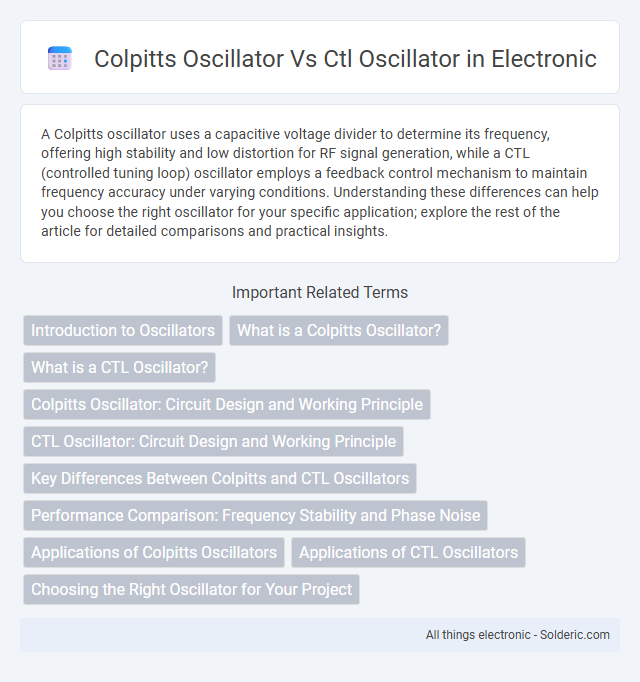A Colpitts oscillator uses a capacitive voltage divider to determine its frequency, offering high stability and low distortion for RF signal generation, while a CTL (controlled tuning loop) oscillator employs a feedback control mechanism to maintain frequency accuracy under varying conditions. Understanding these differences can help you choose the right oscillator for your specific application; explore the rest of the article for detailed comparisons and practical insights.
Comparison Table
| Feature | Colpitts Oscillator | CTL Oscillator |
|---|---|---|
| Oscillation Principle | Uses capacitive voltage divider for feedback | Uses combined capacitive and inductive elements for feedback |
| Feedback Network | Two capacitors in series (C1, C2) | Coupled Tank comprising capacitor, transistor, and inductor |
| Frequency Stability | High frequency stability due to capacitive divider | Moderate frequency stability |
| Frequency Range | Typically high-frequency (RF applications) | Low to mid-frequency range |
| Complexity | Simple and widely used | More complex circuit design |
| Applications | RF signal generation, clocks, transmitters | Audio oscillators, specialized signal generation |
Introduction to Oscillators
Colpitts oscillators utilize a capacitive voltage divider for frequency determination, offering high frequency stability and low phase noise, making them ideal for RF applications. CTL (Capacitor-Transistor-Like) oscillators, though less common, integrate transistor characteristics with capacitive elements to achieve tunable oscillation frequencies with simple circuit designs. Your choice between these oscillators depends on the specific frequency range, stability requirements, and circuit complexity in your application.
What is a Colpitts Oscillator?
A Colpitts oscillator is a type of LC oscillator that uses a combination of inductors and capacitors to generate sinusoidal waveforms at a specific resonance frequency. It features a distinctive capacitive voltage divider formed by two capacitors in series, which determines the feedback necessary for sustained oscillations. Your electronic circuits benefit from the Colpitts oscillator's stability and simplicity in generating high-frequency signals.
What is a CTL Oscillator?
A CTL oscillator, or Capacitor-Transistor Logic oscillator, is a type of electronic oscillator that uses a combination of capacitors and transistors to generate a stable frequency signal typically in digital circuits. Unlike the Colpitts oscillator, which relies on an LC tank circuit for frequency determination, the CTL oscillator emphasizes switching action of transistors combined with capacitive feedback for oscillation. This design enables compact integration on silicon chips, making CTL oscillators preferable in integrated circuit applications requiring precise timing signals.
Colpitts Oscillator: Circuit Design and Working Principle
The Colpitts oscillator features a transistor or operational amplifier with a capacitive voltage divider in its LC tank circuit, which determines the oscillation frequency by the combined effect of inductance and divided capacitance. Its working principle relies on positive feedback generated through the capacitive divider to sustain oscillations at a specific resonant frequency. Compared to other oscillators, the Colpitts design offers stability and ease of frequency tuning by adjusting the capacitance values in the voltage divider.
CTL Oscillator: Circuit Design and Working Principle
The CTL oscillator utilizes a crystal, inductor, and capacitor in its tuned circuit to achieve highly stable frequency oscillations, often employed in RF applications requiring precise control. Its circuit design integrates the crystal with an LC tank, leveraging the crystal's mechanical resonance combined with the inductance and capacitance to maintain oscillations at the desired frequency. The working principle centers on the feedback network where the crystal's piezoelectric properties stabilize the frequency, while the inductive-capacitive elements fine-tune and sustain oscillation amplitude.
Key Differences Between Colpitts and CTL Oscillators
Colpitts oscillators use a capacitive voltage divider for feedback, while CTL oscillators rely on a combination of capacitor and transformer coupling to sustain oscillations. The frequency stability in Colpitts oscillators is primarily determined by the ratio of capacitors in the feedback network, whereas CTL oscillators derive their frequency from the inductive coupling characteristics of the transformer. Your choice between these oscillators depends on whether you prioritize simple design and ease of tuning (Colpitts) or enhanced frequency stability and isolation (CTL) in your circuit.
Performance Comparison: Frequency Stability and Phase Noise
Colpitts oscillators typically offer superior frequency stability due to their capacitive voltage divider feedback, which minimizes variations caused by component tolerances and temperature changes. In contrast, CTL (Capacitively Tuned Loop) oscillators may exhibit higher phase noise because of their loop configuration and tuning elements, making Colpitts oscillators preferable for low-noise applications. Your choice depends on whether frequency stability or phase noise performance is more critical in your specific electronic design.
Applications of Colpitts Oscillators
Colpitts oscillators are widely used in RF signal generation, local oscillators in communication receivers, and frequency synthesis due to their stable frequency output and low phase noise. They are preferred in applications requiring precise frequency control such as signal modulators and demodulators in wireless transmitters. Compared to CTL oscillators, Colpitts types offer simpler design and effective high-frequency operation in VHF and UHF bands.
Applications of CTL Oscillators
CTL oscillators are widely used in communication systems for generating stable and low-phase-noise microwave signals essential in radar and satellite transmissions. These oscillators provide precise frequency control, making them ideal for high-frequency applications in signal processing and wireless communication devices. Their ability to operate efficiently at gigahertz frequencies ensures reliability in advanced electronic circuits and instrumentation.
Choosing the Right Oscillator for Your Project
Colpitts oscillators provide stable frequency output with fewer components, making them ideal for high-frequency applications where simplicity and low phase noise are critical. CTL oscillators offer greater frequency tunability and are preferred in projects requiring precise frequency control across a broader range. Selecting between Colpitts and CTL oscillators depends on the project's specific needs for frequency stability, tuning range, and circuit complexity.
colpitts oscillator vs ctl oscillator Infographic

 solderic.com
solderic.com